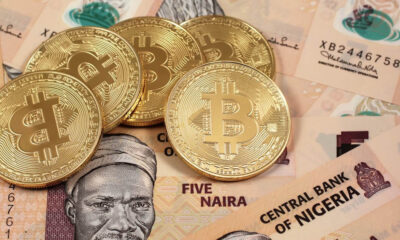Markets
Struggling For Parity
Things sure are looking messy out there right now, especially in Forex Land where the Euro is within a hair’s breadth of trading at parity with the US Dollar this morning.
Published
3 years agoon

By Jeffrey Halley, Senior Market Analyst, Asia Pacific, OANDA
Things sure are looking messy out there right now, especially in Forex Land where the Euro is within a hair’s breadth of trading at parity with the US Dollar this morning. Overnight, the single currency slumped by 1.45% to 1.0040 as Euro yields edged lower as markets fell over themselves to price in a European recession. Energy, and by this, I mean Russian energy, lies at the heart of Europe’s turmoil, with news that Canada would release a specialised gas pipeline pump back to Russia to keep the petajoules flowing having no positive impact. My understanding is that as of yesterday, Nord Stream 1 which carries the fruits of Germany’s energy policies from Russia has entered its annual 10-day maintenance shutdown. The key question is, will the gas return after the 21st of July. Markets seem to be making up their mind already.
The slump by the Euro overnight also dragged Sterling down with it, which faces a messy leadership battle now post-Bojo. Today it was announced that the process would be concluded by err… September 5th. Wonderful. Risk sentiment indicators, the Australian and New Zealand Dollar, were also dragged down the Euro whirlpool as well as investors loaded up on US Dollars and a fair few US government bonds as well by the looks, as US yields fell overnight. Gold, the forgotten asset class, is also trading one-for-one with EUR/USD this morning as well.
As for EUR/USD itself, it has never looked back after it fell through the multi-decade support line at 1.0850 earlier this year. I have no doubt there are plenty of options-related buds just ahead of parity. Likely these are related to 1.0000 knockouts and one-touches and other arcane options “structures”. If previous form is followed, we are likely to see a slow erosion of those bids, along with some dead cat bonces, and when parity finally goes, the stop-losses will kick in sending EUR/USD quickly lower. My charts are thin on the ground at these subterranean levels, but somewhere around 0.9900 looks like the next stop for the train.
US data has thrown the cat amongst the pigeons of course. Friday produced another blockbuster Non-Farm Payrolls, which leapt higher to 372,000. Unemployment was unchanged at 3.60% suggesting Americans are returning to the workforce and are being slurped up by employers. That certainly rained on the “recession-is-nigh” party, something I have been saying isn’t a done deal to global deaf ears. The street is locked and loading another 75 basis points from the Fed at the end of the month. This Thursday’s US Inflation data will be the pivotal moment for financial markets this morning. If headline inflation stays at or above 8.80% YoY, and/or the core stays at 5.70% or above, get ready for a risk-aversion sell-off. Having said that, given the genetic propensity of the equity market FOMO gnomes to buy the dip, lower prints could spark a welcome relief rally in the stock, bond, and currency markets.
Another risk points the street is begrudgingly waking up to at last is China and covid-zero. The city of Wugang is being locked down today for three days, while cases are creeping higher in other parts of the Mainland. That is weighing heavily on China’s equities right now with Mainlanders rightly worried that more lockdowns, especially in Shanghai or Beijing, could occur. That has overshadowed excellent lending data released this week, as banks respond to central government exhortations to get play their stimulus part. ASEAN markets are yet to wilt, although the Northern Asia heavyweights geographically collocated certainly are. That could be because of their correlation to the Nasdaq though. The value-heavy ASEAN stock markets are looking like a safety play this morning, I’m not sure how long that will last.
Japan’s Finance Minister Suzuki has been on the wires this morning as USD/JPY approaches 138.00 saying Japan will take “necessary steps” in the forex market, as necessary I suppose. He also said that they would be closely communicating with other FX authorities internationally. This is the usual rhetoric when things don’t go to plan, and I do not believe we are imminently going to see the Ministry of Finance intervening in USD/JPY. (sidenote: the MOF makes the call on intervention; the BOJ merely executes it.) I am a little surprised that USD/JPY has remained at these levels, just as I am certain other “authorities” have bigger fish to fry right now and don’t think the Yen’s depreciation is a threat to global financial stability. If the MOF intervenes, it’ll be doing it alone. Probably the best hope Japanese authorities have for some Yen relief is a slump in US yields triggering a culling of the heavily long USD/JPY open interest out there.
China will also be front-and-centre at the end of this week amongst the tier-1 US data dump. On Friday, it releases its House Price Index, Industrial Production, Retail Sales, Fixed Asset Investment, and Unemployment for June, as well as quarterly GDP Growth and Capacity Utilisation. Although virus nerves will captivate the short-term attention of traders and investors, the data will go a long way to answering how well-placed China is to weather another bout of Covid lockdowns.
Tomorrow, we get rate decisions from the Bank of Korea and Reserve Bank of New Zealand as well as China’s 1-year Medium Term Facility Rate. The lending numbers from China this week mean there is no urgency to lower the 1-year MTF. The Bank of Korea is on track to announce a punchy (by their standards), 0.50% rate hike after recent elevated inflation data and a rapidly weakening Won in the face of the Dollar juggernaut.
The Reserve Bank of New Zealand is being bandied around as the canary in the coal mine for other central banks, having started normalising policy sooner than other developed market central banks. That is giving the RBNZ far too much credit, only the Central Bank of Turkey has done a worse job. The RBNZ kept quantitatively easing as inflation exploded in New Zealand and sent house prices spiralling. Having sat like a possum in the headlights while the cost of living spiralled out of control and presided over the greatest transfer of wealth ever from our young people to our old people, they were then tardy and timid in stopping QE and then raising interest rates. They have nicely set up the country for an abrupt slowdown this year. A 0.50% rate hike is baked in, but the attention will be on whether they indicate a slower pace of hikes going forward. Given the stagflation nightmare they created, this would be a mistake and all I can say to any central bankers reading this newsletter is if the RBNZ blinks, you should absolutely do the opposite. The RBNZ is a reverse leading indicator, not a leading indicator. (NB: I am a Kiwi, and you may have noticed, that I am a bit upset with the RBNZ).
Data released today in Asia have been second-tier. Japan’s June PPI rose by 9.20% YoY, higher than expected, and the Bank of Japan sticking to an easy monetary policy, has kept up the pressure on the Yen. The Philippines’ Balance of Trade was worse than expected, falling to $-5.678 billion in May as imports exploded. Once again, a deteriorating trade balance will keep the pressure on the Peso, already at record lows. Australian Consumer and Business Confidence data was weak, but a much lower Australian Dollar overnight is keeping local equities supported.
This afternoon sees the release of the German ZEW Economic Sentiment Index for July. It goes without saying it has serious downside risks and will be another headwind for the Euro and European equities this afternoon. India’s Inflation data this evening should see YoY Inflation remaining above 7.0% as the Indian Rupee slump continues and energy prices remain firm. The US 10-year note auction will be worth watching, with heavily US bond issuance this week. A weak bid-to-cover could give the US Dollar rally a reason to pause, while the API Crude Inventories could lift oil prices if the headline number falls sharply from last week’s 3.8 million-barrel gain.
Asian equities are mostly lower.
Wall Street went back into recession mode overnight, with the growth-centric Nasdaq underperforming as tech heavyweights were sold off. The Nasdaq’s fall has translated directly into weakness with the correlated North Asia heavyweights, while the rest of Asia and Pacific has escaped mostly unscathed. Covid-19 fears in China continue to hang like a dark cloud over the region, however.
Overnight, the S&P 500 fell by 1.15%, with the Nasdaq tumbling by 2.26%, while the Dow Jones finished 0.52% lower. The giant Non-Farm Payrolls number has given Wall Street food for thought on US rate hikes, with the FOMC looming at the end of the month, even as haven flows sent US yields lower across the curve. In Asia, US futures continue to fall with futures on all three major indexes down by around 0.50%.
The continuing retreat of US futures, along with the Nasdaq slump overnight and lockdown fears in China sees most of Asia lower. Japan’s Nikkei 225 has slumped by 2.0%, with South Korea’s Kospi dropping by 1.20%. In Mainland China, lockdown fears see the Shanghai Composite 1.0% lower, with the CSI 300 falling by 1.20%. Hong Kong’s Hang Seng is also 1.20% lower.
In regional markets, a holiday in Singapore and Malaysia yesterday see the Straits Times managing to remain unchanged, but the KLCI has fallen by 0.45%. Taipei has tumbled 2.55% lower. Jakarta is down just 0.05%, with Bangkok and Manila easing by 0.40%. A lower Australian Dollar seems to be boosting the resource-heavy Australian markets today. The ASX 200 is 0.20% higher, while the All Ordinaries has gained 0.40%.
Asia is roughly mirroring the Wall Street growth/value split overnight. Unfortunately, European markets are unlikely to find much solace because of that. Energy concerns and a slump by Wall Street overnight are likely to see European bourses open well in the red this afternoon.
US Dollar tramples all before it.
The US Dollar caught another flight-to-safety boost overnight, running rampant over DM currencies with the Euro, Sterling, Yen, and Australian Dollar coming in for particular attention. In Asia today, EUR/USD continues to flirt with parity, while the US Dollar has strengthened broadly across the Asia FX space.
The dollar index soared 1.23% higher to 108.21 overnight, gaining another 0.16% to 108.38 in Asia as Euro and Sterling losses continued. Overall, the technical picture remains constructive for the dollar index, although the daily relative strength index (RSI) is now in overbought territory, suggesting a temporary downward correction is possible. Having broken out of a 5-year triangle at 102.50 in April, its longer-term target remains in the 1.1700 area. More immediate resistance is at 108.45 and 110.00. Support is at the 1.0585 breakout point, and then 1.0500, followed by 1.0350 and 102.50.
EUR/USD tumbled by 1.43% to 1.0040 overnight, edging 0.17% lower to 1.022 today, having traded as low as 1.0006 earlier in the session. I expect there to be plenty of bids into parity initially, likely option and exporter-related. A break of 1.0000 is likely to trigger a sharp move lower as stop-losses and algos kick in. Since breaking a multi-year support line at 1.0850 in April, Euro has looked consistently weak, the recovery rally failing ahead of 1.0850 in a technical analysis nirvana. An oversold RSI allows for short-term recovery, with resistance at 1.0200 and 1.0270. Support is at 1.0000, and failure targets the 0.9900/25 area.
GBP/USD fell by 1.19%% to 1.1890 overnight, dragged lower by the Euro and a rampant US Dollar. With a new Prime Minister not due to be announced until early September, this uncertainty will continue to weigh on the sterling. In Asia GBP/USD has edged 0.20% lower to 1.1867. Immediate support is nearby at 1.1860 and 1.1800, with 1.1400 the medium-term target. Resistance is well defined at 1.2060 and 1.2200.
USD/JPY rallied by 0.98% to 137.40 overnight despite US yields easing. In Asia, it is steady at 137.30 as Finance Minister Suzuki’s comments add some two-way risk into being long USD/JPY at these levels, at least temporarily. USD/JPY has resistance at 138.00 and 140.00, with support at 136.00, 134.25 and 132.00. Only a sharp fall in US yields seems likely to turn USD/JPY lower.
AUD/USD slumped by 1.70% overnight to 0.6735 on a combination of haven-based US Dollar buying, a reversal in global investor sentiment, and China lockdown concerns. In Asia, it has eased 0.17% lower to 0.6725. A correction above resistance at 0.6900 looks unlikely for now, with risks skewed towards the downside and a test of 0.6600. NZD/USD also plummeted overnight and is facing a test of 0.6100 today.
Asian currencies fell overnight as investors moved into risk-aversion mode and bought US Dollars across the board. The Won, Baht and Yuan led losses, and today USD/Asia is higher by around 0.30%, with the Philippines Peso falling 0.60% after poor trade data, while USD/IDR is testing 15,000.00 and USD/MYR looks set to test 4.4500. USD/INR and USD/PHP are trading at record lows although the price action in USD/INR, USD/IDR, USDKRW, USD/PHP and USD/THB suggests that local central banks are offering US Dollars at these levels. That is likely to be smoothing rather than lines in the sand, and US inflation above 7.0% this Thursday will probably spur more selling. USD/CNH has also moved sharply higher in the last 24 hours, and any indication that China is enacting lockdowns again in major urban centres will see it and the rest of the Asia FX space move sharply lower.
Oil trades sideways overnight.
Oil prices had another choppy session overnight but ultimately traded sideways, booking just modest losses. Markets remain torn between recession fears in the US, Europe, and China torpedoing growth and thus, oil consumption, and the still very tight supply/demand reality of the physical market. Little hope is being assigned to Biden’s visit to Saudi Arabia unlocking more production from them or the UAE. The price is likely to be very high to achieve that.
Brent crude finished 0.70% lower at $106.25 overnight, while WTI fell 1.30% to $103.35 a barrel. News that a court in Russia has overturned the environmental ban at the Kazakh’s Black Sea terminal in Russia, has sent oil prices slightly lower in Asia. That is likely to be temporary given the Russian judicial system, and it seems that China’s lockdown fears are keeping oil prices offered in Asia. Brent crude is 0.80% lower at $105.35 a barrel, with WTI falling by 1.10% to $102.30 a barrel.
Reports that Iran is about to sell 100’s of drones, some armed, to Russia could be a body blow to any nuclear deal with the west. That means that the chances of Iranian crude returning legally to international markets in greater volumes is receding and could prove supportive of prices as the day goes on.
Brent crude has resistance at $107.50 and then its 2022 trendline breakout at $108.85, followed by the 100-day moving average (DMA) at 110.75. It has traced double bottom at $103.75 and $98.60, followed by the 200- day moving average (DMA) at $96.75 a barrel. WTI has resistance at $105.00 and then its 100-DMA at $107.50 a barrel. Support is at $101.00 and then $96.60.
Gold is soggy in Singapore.
The wholesale retreat of investor sentiment overnight saw massive inflows into the US Dollar, pressuring gold once again. Gold fell 0.50% to $1734.00 an ounce overnight. In Singapore, gold has had a choppy $1723.00 to $1744.00 range this morning and appears to be trading tick-for-tick with movements in EUR/USD today. As such, a break of parity by EUR/USD will signal a test of $1700.00 by gold. As I write, gold is down by 0.30% to $1729.00 an ounce in Asia.
Since breaking $1780.00, gold’s technical picture has deteriorated rapidly, and it is clear it remains at the mercy of the US Dollar’s direction. The only positive note to be seen is that its RSI is now in very oversold territory, allowing for a modest corrective rally to occur if a downward correction in the US Dollar happens. Despite four sessions of sideways trading, gold remains anchored at the bottom of its range and only a miracle slump by the US Dollar this evening is likely to move it off the seafloor.
Gold has resistance at $1780.00, $1785.00, and $1820.00, its downward trendline. Support is at $1720.00, followed by $1675.00. Failure of longer-term support at $1675.00 sets in motion a much deeper correction, potentially reaching $1500.00 an ounce.
Is the CEO and Founder of Investors King Limited. He is a seasoned foreign exchange research analyst and a published author on Yahoo Finance, Business Insider, Nasdaq, Entrepreneur.com, Investorplace, and other prominent platforms. With over two decades of experience in global financial markets, Olukoya is well-recognized in the industry.

You may like
-
International Tensions Push Gold to $2,700 Per Ounce
-
Gold (XAUUSD) Stabilizes Below $2700: An Analysis of Hesitation Ahead of Inflation Data
-
Bitcoin to Replace Gold as the ‘Premier Store of Value’ Asset in The Next Decade
-
Gold Soars to Record $2,740/oz as Investors Seek Safe Haven Amid Economic Uncertainty
-
Gold Prices Below $2,630, and the Fed Minutes Will Decide Market Direction
-
Osun Government Seals Off Gold Mining Company For Allegedly Evading Tax











